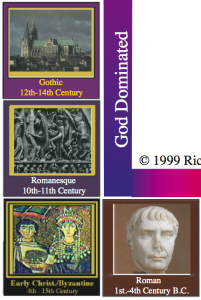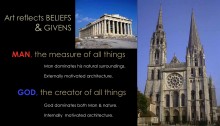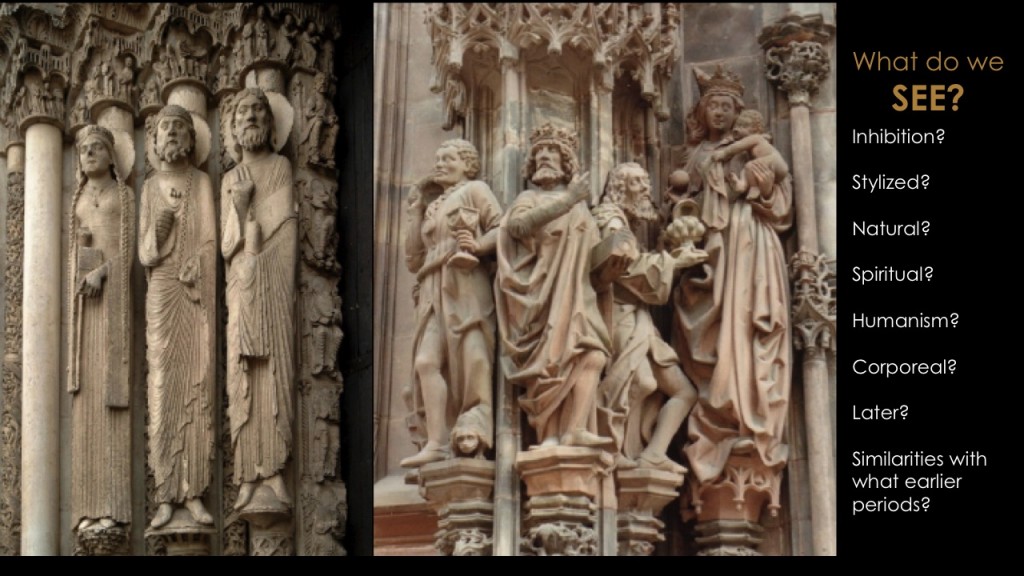 The third session of the “Art is Us” art history class for Spring 2015 was held on Thursday, April 2. We discussed the homework assignment comparing two Gothic sculptures, and viewed a presentation covering over 1400 years of art and architecture, from Roman to Early Christian, Byzantine, Romanesque and Gothic periods. We’re starting to see some themes repeat.
The third session of the “Art is Us” art history class for Spring 2015 was held on Thursday, April 2. We discussed the homework assignment comparing two Gothic sculptures, and viewed a presentation covering over 1400 years of art and architecture, from Roman to Early Christian, Byzantine, Romanesque and Gothic periods. We’re starting to see some themes repeat.
Homework assignment
There are two homework assignments this week. The first is to compare the two artworks pictured, using the 3-part format (Identification, General Statement, and Supporting Evidence) from last week. This Khan Academy video provides some background information on one piece. The second is a new “5 tribes” game.
[gview file=”https://dicknelsoncolor.com/wp-content/uploads/2015/04/AIU-HomewrkLec4.pdf” height=”300px”]
[gview file=”https://dicknelsoncolor.com/wp-content/uploads/2015/04/SpaceTribes.pdf”]
Class recap
Homework discussion
The homework assignment was to compare two Gothic sculptures, making use of the comparison format provided in class: Identification, General Statement, and Supporting Evidence.
Small groups were formed to develop a joint statement and report. Dick asked questions and provided hints for how to approach these assignments, and what to look for.
Identification – What are we comparing? This may include the following if relevant: 1. Artist. 2. Name of piece. 3. Medium. 4. Period.
We are comparing two sculptures with a religious theme that are part of the exterior of Chartres Cathedral (left, 12th century, early Gothic) and Notre Dame de Strasbourg (right, 15th century, later Gothic).
General Statement – Why were these two pieces chosen? What is significant about them?
This comparison provides an example of the cyclical nature of art history. In this case we see the similarities of early and late Gothic sculpture and their Greek counterparts, i.e., Archaic and Hellenistic. The spiritual focus of the left figures are in sharp contrast to the more “this world” emphasis of the right hand sculpture.
Supporting Evidence – Specific evidence in support of the general statement.
The earlier work displays the same contained, inhibited and stylized elements found in Archaic sculpture. The figures are elongated and lack believable reference to true anatomy and fabric. Where reference is made to our world of appearance, stylization replaces factual representation. The later work presents natural, uninhibited figures whose bodies and facial expressions replicate life as it is in a full 3D spatial relationship.
Art Maui
Art Maui opens next week, and Dick will lead a group tour. Three people from this class had work selected for this year’s exhibition: Bonnie Fox, Sheri McNerthney, and Don Shamblin. There were questions about what happens in the jurying process, and this year’s juror.
Lecture & slideshow: Roman, Early Christian, Byzantine, Romanesque, and Gothic art and architecture
Continuing our tour of western art history, the lecture this week covered Roman, Early Christian, Byzantine, Romanesque, and Gothic art and architecture.
Roman
The Romans had access to the art of earlier nearby civilizations, the Greeks and Egyptians, and created works reflecting those cultures. Their strength was more in engineering than aesthetics, though. Their inventions included concrete, which led to building colossal structures; the enormous dome of the Parthenon, held up by walls 16 feet thick, allowing a much more open interior than previous techniques; and the rounded Roman arch, able to span distances with less weight than post and lintel structures. Their artwork copied both the idealized classic Greek style and the literal Hellenistic style. In painting, they created sophisticated 2D renderings of 3D scenes, including foreshortening, and effects of light and shadow, reflecting their concern with the secular reality of this world. Even mythical characters and gods displayed human physical characteristics.
Early Christian
The architecture of early Christian churches continued using Roman arches, but soared to new heights and dazzled church-goers with colorful mosaics and glittering gold, creating a heavenly, other-worldly atmosphere. The space was organized into a trinity, consisting of a central nave (ship of God) and two side aisles.
Byzantine
Byzantine architecture was characterized by domes supported on pendentives, opening up the interior space and allowing more light in. Art returned to a flatter, more symbolic and less naturalistic style, reflecting a concern with spirituality rather than the natural world.
Romanesque
The architecture of the middle ages, with thick walls and few windows, was closed off and protective. Feudal lords ruled over serfs in small regions and their fortress-like castles and towns provided protection from invading attackers. God, also, was viewed as a lord, with the power to judge and punish the populace. The illiterate masses viewed the scenes depicted in the reliefs on church walls and absorbed the value of obedience. The term “Romanesque” comes from the use of Roman-style arches. Heavy walls enclose a large interior space representing the intangible but significant presence of God.
Gothic
The feudal states of the middle ages were eventually united into nations or kingdoms, and protection became less of an issue in daily life, allowing new values to emerge and corresponding innovations in art and architecture. Set on a hilltop, Chartres Cathedral dominates the city, suggesting the significance of faith in this age. The building itself is “an encyclopedia of Christian belief” of the time. The spires “dematerialize” as they point into the air, the realm of God, and the lace-like exterior is almost spongy, permeable. The pointed interior arches, combined with the exterior flying buttresses, allow the building to soar high into the air. The interior masonry takes on the colors of light passing through the stained glass windows. The effect combines with music and chanting to transform the everyday world into the world of God. Everything is built to honor the glory of God, and everything in the world is God’s creation, including the furs and furrier (and other professions) depicted in the stained glass windows.
The 2009 version:
Lecture audio and notes
Audio of lecture, part 1, slides 4-22 (1:03 hours)
Audio of lecture, part 2, slides 23-39 (1:17 hours)
Holly shared the detailed notes below, a transcript with key concepts emphasized, and augmented with supplementary material.
[gview file=”https://dicknelsoncolor.com/wp-content/uploads/2015/04/Class3_HollysNotes.pdf”]
Summary
Today we’ve seen how transformations in societies were reflected in their art and architecture. We can only touch on a few key points for each period, so look online or in books if you’re interested in more details or a deeper understanding. The purpose of this class is to develop the student’s capacity to objectively analyze an unfamiliar piece of art, by introducing a framework of long-term trends and universal principles, and by exercising observation and analytical skills. Memorizing specific facts like names, dates, and locations is not important, since they can be easily found online.
Dick said, “This course will be very easy if you recognize that the same patterns show up over and over.” And, “Look for the link between my world view and what I build. There’s a strong link between what I believe and how I perform as an artist. This is what makes the history of art so important: all arts are representative of the beliefs of the time.” For example, drawing and color are no longer considered important in art schools; they value conceptual art. Dick reserves the term “contemporary” for art which is in tune with the values and technology of the time. Much recent and current art is labeled “contemporary” but could as easily have been produced in the 19th or 20th century.

